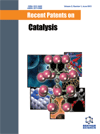Recent Patents on Catalysis (Discontinued) - Current Issue
Volume 2, Issue 2, 2013
-
-
TiO2 Supported Photobiocatalytic Systems
More LessWe report on a performance of the photocatalytic solar energy convertors based on mesoporous TiO2 films with immobilized enzymes and membrane pigment-protein complexes of bacterial reaction centers Rhodobacter sphaeroides and Synechocystis sp. PCC 6803 photosystem-I (PS I) using our patented immobilization technique. These semiconductor- enzymes-pigment-protein systems functioned as both the light-harv Read More
-
-
-
Recent Developments in Catalytic Micro Process Engineering for Fine Chemicals Synthesis
More LessAuthors: Marc Escriba and Alex O. IbhadonIn this review, recent developments in fine chemicals synthesis, catalysis, microreactor design and applications are discussed. Specifically, new advances in continuous micro process engineering, packed-bed devices and photoreactors are discussed to include recent patents in these areas. In addition, new energy sources including ultrasounds and microwaves integrated into microstructured reactors are also discussed. Nov Read More
-
-
-
Patents on Photocatalyst Incorporated Cement Based Materials
More LessAuthors: Mert M. Oymak and Deniz UnerThis patent survey emphasizes applications of photocatalyst incorporated cement based materials. The patents from two companies, i.e., Italcementi and Toto Ltd., were emphasized in the manuscript due to their greater number of patents. The product survey reflected the current commercial photocatalysis market. Construction sector applications dominated the patents and products.
-
-
-
Selective Isomerization of p-Diisopropylbenzene to m-Diisopropylbenzene Over Metal Modified Hβ Zeolites
More LessAuthors: Mahesh S. Edake and Shriniwas D. SamantIsomerization of p-diisopropylbenzene (p-DIPB) to m-diisopropylbenzene (m-DIPB) was carried out using metal modified Hβ zeolites at high temperature and in the absence of a solvent. The metal cations used for the modification of Hβ were typical Lewis acidic cations Fe3+, Al3+, Ti4+, Sn4+ and Sb3+. The modified zeolite catalysts were heated at 120°C, and calcined at 280°C, and 550°C. They were characterized by X Read More
-
-
-
Semiconductor Reactor Technology -Patents and Recent trends in Photocatalytic Decomposition of Pesticides and other Xenobiotics
More LessAuthors: Vedagiri Amulya and Atmakuru RameshPhotocatalysis is an important process used in the decomposition of chemical residues, which are mostly xenobiotics present in contaminated water. The hydroxyl radical technology using a semiconductor with low energy UV light source has the advantage of oxidation and decomposition process when compared to other conventional techniques resulting in the decomposition of toxic chemicals to non toxic CO2 and water. Read More
-
Volumes & issues
Most Read This Month Most Read RSS feed
Article
content/journals/rpcat
Journal
10
5
false
en


